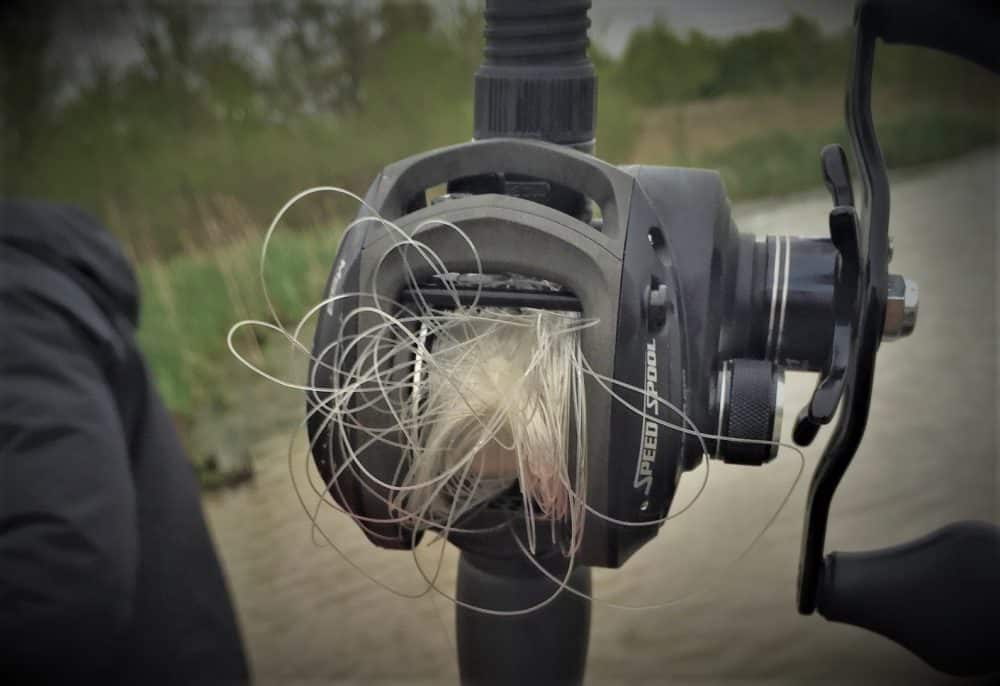Beginner fisherman throughout the world have been suffering in silence (maybe not in silence) with their baitcasting reels. Reel Backlash is a serious problem when first getting used to a new baitcast reel. After staring down a few bird nests in your reel you start to second guess whether or not it’s worth it.
Just remember that as hard as it may seem, baitcasters offer a lot of advantages over spinning reels. You’ll be able to handle bigger line, which means bigger fish, have farther more accurate casts and take advantage of all the newest fishing technology. Before you can reel in that monster bass you need to figure out how to get past that whole backlash/birds nest problem.
What is Backlash?
Before we get to far into this article it’s important to know exactly what backlash is. When you hold down the thumb button on your baitcaster this allows your spool to spin freely. If your spool is too tight you’ll have short inaccurate casts, but if your spool is too loose it’ll leave out excess line.
The good thing is that even cheap reels these days have anti-backlash systems. Check out all these cheap baitcast reels on amazon if you don’t believe me. Even the budget no name reels that cost 20-30 bucks have dual breaking systems. I’m not saying you should get the cheapest reel on the market, but something like a budget Abu Garcia Blackmax reel will work just fine.
This excess line is what results in backlash, which comes into a tangled mess. If you don’t know how to properly setup your reel it’s going to make casting a lot more difficult and frustrating. Your goal should be to control your line just enough that it stops the excess line without effecting your cast.
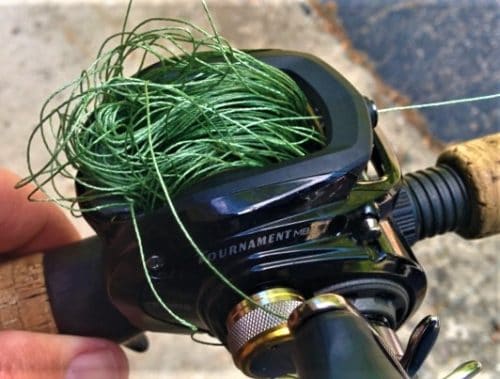
How To Stop Baitcaster Backlash
You’re on a early morning hot streak, fish are going nuts striking everything you throw at them. Cast your lure out in a graceful arc and kersplunk. It’s the sound backlash making a mess of your morning. After throwing a few obscenities your reels way you sit down and start picking out your line. Could you have prevented this annoying birds nest of a problem?
Reel makers have been increasing their reel design in the past 10-20 years finding ways to make baitcast reels easier to use. They’ve been coming out with anti-backlash controls that it seems like only the masters have figured out. You don’t have to be a fishing expert to take advantage of all the controls on your reel. After you figure out what they do even a beginner can develop a good casting rhythm.
Don’t Ignore Your Anti Backlash Settings
I don’t know who all these so called experts are that keep telling people to ignore their anti-backlash settings. I’ve even seen advice stating that they should be shut off altogether. Maybe they’ll do more harm than good if you don’t understand how they work, but with a few hours of practice and a few lure swaps you’ll quickly get your settings dialed in.
Your Anti Backlash Settings Shouldn’t Be Static
It doesn’t matter what backlash system you have in place you can dial in a good setting with just about any lure. Just remember that what works for one lure will likely need to be slightly adjusted for another. With a little practice you’ll be able to dial in these adjustments on the fly.
How To Adjust The Anti Backlash Setting
On the side of most modern baitcast reels you’ll see a dual braking system that helps control the backlash during the cast. Most of the time there are two knobs on opposite sides of the reel that control the backlash.
The Knob on the handle side of your reel controls the beginning of your cast. If you’re getting a lot of backlash right at the beginning of your cast as the spool starts to spin, you’re going to want to tighten down this knob. Over-tightening the knob will cause a whole other set of problems.
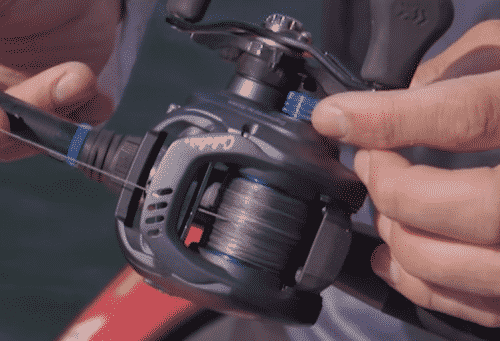
The knob on the other side of the reel controls the brakes on the back end of your cast. If the line seems to come off smooth at the beginning and starts to wind to fast towards the end dial these numbers up. The higher the numbers go up the tighter it’s going to be. Increasing the tightness will reduce the speed of your spool which will shorten your casting distance, but reduce backlash.
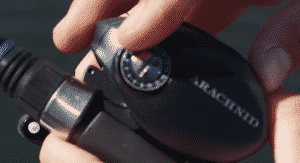
Initial Anti Backlash Adjustments
When you first setup your bait cast reel tighten the centrifugal braking knob next to your Handle all the way down. You should notice that your reel won’t allow any line to fall off the spool when you engage the reel. Leave the reel engaged slowly backing off the knob until the spool barely starts to spin. Let your lure slowly go down and hit the water and you shouldn’t have any backlash.
The other side should be numbered which should make setup pretty easy. These numbers control the magnetic braking system. I like to go to the medium setting and dial it down 2-3 notches. Further fine tuning might be necessary if you end up losing line late in your cast.
Your Cast Hooks Left or Right
So you think you have all your adjustments right and you cast your line. You don’t have any backlash, but your lure doesn’t go where you want it to. When your cast hooks off to the left or right that means you’ve either got a little bit of excess drag on your brake, or your release point on your cast is a little bit late. Most of the time loosening up your spool will immediately correct your problems.
Stop The Spool Before It Hits The Water
The number 1 mistake most beginners make is that they don’t feather the line as they cast. Even after setting the braking system make sure you hold your thumb over the line as you cast. This limits the amount the line can lift up off your spool. Before your line hits the water place your thumb down on the line stopping the spool before you bird nest.
Different Braking Systems
There are two different styles of braking systems that are on every modern baitcast reel. You have a centrifugal and magnetic braking system. The centrifugal braking system limits how much line is left off your spool at the beginning of your cast and the magnetic controls the line left out on the back end.
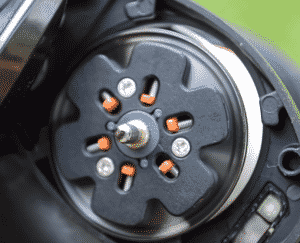
How to Fix Baitcast Reel Bird Nests
So you’ve screwed up and are left with a massive mess inside your reel. Don’t worry it happens to everybody, but that doesn’t mean it’s any easier to fix. Fortunately it isn’t all that difficult to untangle that mess in your reel if you know what you’re doing. Don’t resort to bringing out your scissors and knife before trying this first.
- So you have a big birds nest in your reel how do you fix it? To fix your backlash first pull the line out as much as you can.
- Eventually as you’re pulling out the line you’ll get to a spot that starts to cause issues. There’s just to much tangle for the line to be pulled out any farther. Don’t be like the majority of people that think extra pulling is going to solve the problem. Instead you’re going to want to Engage the Reel.
- Once your reel is engaged press down with your thumb on top of the birds nest of line.
- Turn the handle a little bit as you’re pressing down on the line and spinning the spool.
- Try to pull the line out again until you get stuck up on another bit of knotted up line. Again you’re going to want to repeat the process placing your thumb on the line and turning the handle.
- You’ll notice that as you continue to pull out the line your thumb is actually freeing up the tangles.
- Keep repeating the process until your thumb completely frees up all the backlash. Sometimes it takes one or two times others it takes a while, but most of the time you should be able to free up your line in under a minute or two.
What if The Thumb Trick Doesn’t Work?
The main thing that you have to remember when using the thumb trick or any other clearing process is patience. Yes this process works and it works well, but sometimes you just have so much of a mess that the thumb trick doesn’t work. I notice this a lot with kids who think that by forcing their line they can clear it or they just try to continue to cast with a big knotted up line(unsurprisingly this doesn’t work). When you start to get frustrated resist the urge to yank the line, because this just makes matters worse.
If things are so bad that you’re getting frustrated just cut the line. Line is cheap and it isn’t worth wasting your time and patience getting frustrated. Just remember that if you cut your line to follow this one thing. Make sure that after you cut the line it isn’t all wound up on itself. When the line is all up under itself on the spool it won’t play freely on your cast. This is going to create a tangle that’s much worse than the one you had before.
How to Cast a Baitcast Reel
You cast a baitcast reel the same way you would cast any other. The actual movement is the same, but their’s a little more that goes into it. So what goes into the perfect cast?
- Practice With Monofilament Line: If you’re new to baitcast reels you need to start out using monofilament line. It doesn’t matter how skilled you are with a spinning reel you’re going to have issues making the transition. Monofilament not only significantly reduces backlash, it’s also going to be a lot easier to untangle if you accidentally make that dreaded birds nest.
- Heavy Lures are Easier To Use: Heavier lures are going to be a lot easier to use when first starting out with a baitcast reel. I’m not a physicist so it’s hard to say exactly why, but the added weight seems to stabilize the release of the line. It’s going to pull the line down where a lighter lure might get caught in the wind causing backlash.
- Don’t Mess Around With the Wind: If you’re out on a boat in the middle of a lake you’re going to have to deal with wind. So instead of fighting against it try casting with the wind until you get a feel for your new reel. Casting into the wind will screw up your casting speed making it difficult to set the spooling speed. If you absolutely have to cast into the wind your first time you should tighten your breaks a little more than you normally would.
- Don’t Forget the Anti-Backlash Braking System: I don’t know how many times I’ve read the advice of so called experts recommending you completely shutoff your anti-backlash system. It’s absolutely ridiculous to think manufacturers would hold onto a worthless system that’s been around for decades. If you don’t know how to set your brakes watch the above video for a few pointers.
- Practice A Lot With Short Casts: Short casts are going to be a lot easier when you’re first starting out. You won’t have to worry about your lure catching in the wind and causing trouble. Before you extend the distance let your hands figure out the basic mechanics of the reel.
Don’t Snap Your Cast
So your entire life you’ve been using a spinning reel and making perfect casts. You bring back the rod and with a snap of the rod your lure soars gracefully through the air. You think you know what you’re doing and try to cast your baitcast reel the same way. Before you make this mistake you need to reevaluate your entire cast.
With a baitcast reel you should never snap your wrist while you cast. It doesn’t matter if you use an overhead cast or side arm it will be done exactly the same way. Smooth precise casts are going to be more accurate and go farther than aggressive snaps with your wrist.
Sidearm Vs Overhand Casts
When you first start to learn how to use a baitcast reel do yourself a favor and start off with sidearm casts. Sidearm Casts are going to be a lot easier to pull off vs the overhand cast. You’ll be able to follow your hand throughout the entire casting process perfecting your overall technique. You’ll probably have some backlash problems at first, but after a while you should be able to advance to more advanced casting techniques.

